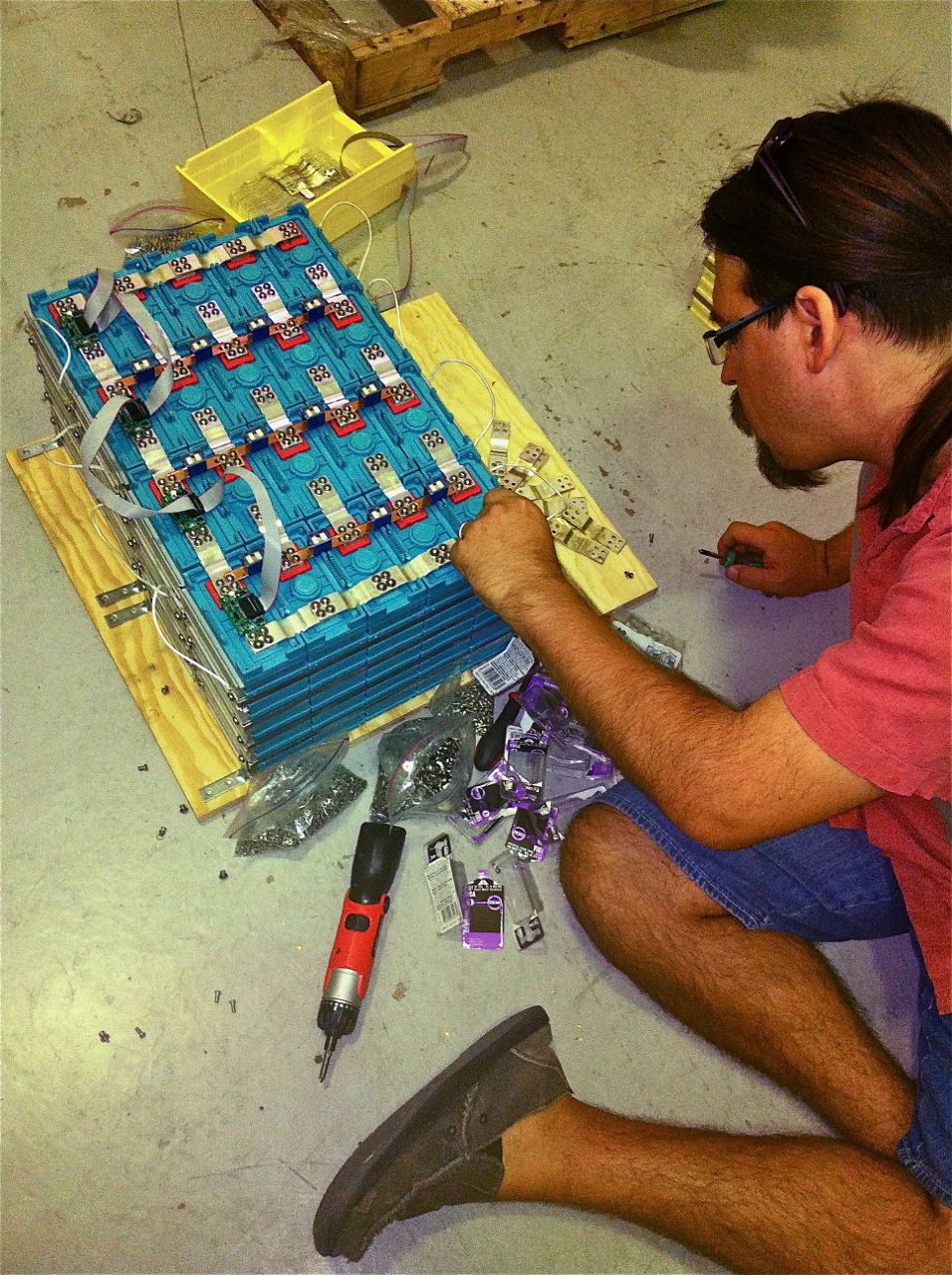
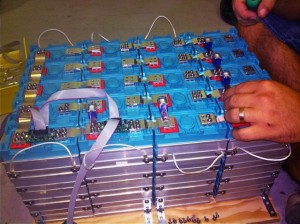
One of the most unusual frequently asked questions we get asked out on the road:
“How’s your lithium batteries working out?”
We’ve even had strangers come up to ask, occasionally without even saying hi first!
But I get the curiosity.
That we are using lithium batteries for our RV house battery bank is one of the more unique things about our already very unique home on wheels.
When we set out to build a 500Ah LFP lithium battery bank 3.5 years ago, we knew we were heading into relatively uncharted territory where only a few had dared to venture before us.
But since the theoretical advantages of lithium batteries in an RV are undeniable, it is only natural that everyone with any interest in RV electrical systems wants to know just how well theory and reality have meshed for us.
People often tell us that they are even holding off on replacing their own aging lead batteries – waiting to hear from us that lithium is at last ready for the mainstream. (No pressure… *grin*)
- After 3.5 years of use, has lithium lived up to all the promises?
- What have been the downsides? Would we do it again? Was it worth the cost?
- And for those wanting to follow in our footsteps, everyone always asks where they should start?
Read on for our ever-evolving thoughts…
Lithium for RVers – A Quick Recap
 Way back in 2011 we shared our research and wrote extensive posts about the disadvantages of lead acid batteries and the inherent advantages of lithium – in particular the lithium iron phosphate (aka LiFePO4 or LFP) cells that were just then becoming practical and (relatively) affordable in the sizes required to build a reasonable RV house bank:
Way back in 2011 we shared our research and wrote extensive posts about the disadvantages of lead acid batteries and the inherent advantages of lithium – in particular the lithium iron phosphate (aka LiFePO4 or LFP) cells that were just then becoming practical and (relatively) affordable in the sizes required to build a reasonable RV house bank:
“As you will soon see, on paper lithium ion batteries seem to be superior in almost every possible way — as if Zeus himself had climbed down from Olympus and handed the world the perfect battery. Or maybe it wasn’t Zeus, but that annoying pink Energizer Bunny, bringing the gift of divine electrons pulsing to the rhythm of his eternal drum.”
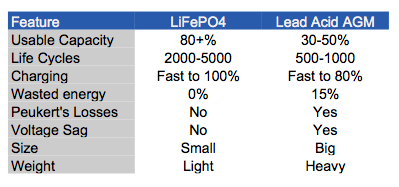
The advantages of lithium over lead are many, but to recap a few of the highlights:
- Superior “Useable” Capacity – It is generally considered smart to treat lead batteries as if they have a useable capacity of only 50% of the actual rated capacity. Lithium batteries on the other hand can be regularly drained 80%, or more.
- Extended Cycle Life – Theory (and lab tests) say that you should expect to get somewhere between 2x – 10x the number of useable cycles out of a lithium battery as you do from even a premium lead battery. If LFP batteries can outlast conventional batteries, this turns into a lifetime cost advantage over AGM despite increased upfront costs.
- Fast & Efficient Charging – Lithium batteries can be “fast” bulk charged to nearly 100% of capacity. Lead batteries on the other hand require a slow absorption phase to get the final 20% of the battery charged.
- High Current Happiness – Due to a phenomenon known as Peukert’s Law, lead batteries drain at an accelerated rate when powering high current loads (like microwaves and air conditioners and induction cooktops) – sacrificing as much as 40% of their capacity in the process. Lithium batteries on the other hand can handle high current charging and discharging without breaking a sweat.
- Smaller & Lighter – A rough rule of thumb is that for a given amount of usable battery capacity, a lithium battery bank will end up being less than half the physical size and just a quarter of the weight of lead.
Clearly – the theoretical advantages are huge.
But the advantage of conventional quality name-brand AGM lead batteries can’t be denied either. Not only are the upfront costs cheaper, AGM batteries are tried and true well established technology with no unknowns and little potential for surprises.
(But, what kind of fun is that?)
Lithium: Ideal for Solar & Boondocking
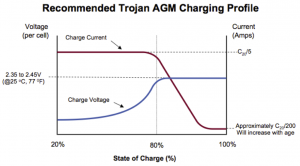
Where lithium really has the potential to shine is when paired with a solar energy system.
You see – when a lead battery is slowly working through an absorption phase (the downward current slope in the graph to the right) pushing the final 20% of power into the battery, excess energy from solar panels ends up being thrown away as the charging current trails off.
With lithium on the other hand, the batteries can keep taking all the current your solar panels are putting out – right up until they are essentially 100% charged.
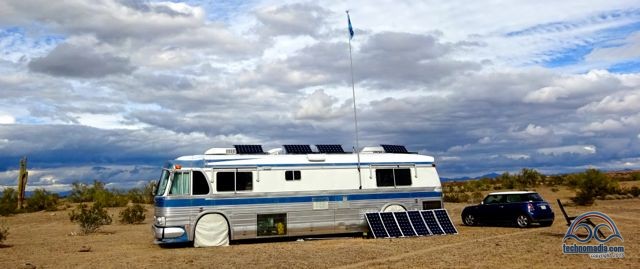
And if you have lead, you better hope that you have enough solar panels and daylight to make sure that you regularly make it fully through absorption and manage a full 100% charge – because lead batteries suffer if not regularly topped off.
Lithium batteries on the other hand could care less if you never fully charge them. Ending the day at 50% or 85% charged is no big deal at all. You could go for months without ever getting a full charge and your batteries will be just fine.
The overall charge efficiency of lithium versus lead is better too – meaning that lithium takes better advantage of every ray of sunlight that you are able to harvest.
Even if you don’t have solar and are using a generator to power your boondocking – lead batteries will require hours more generator run time to regularly complete an absorption charge phase. With the faster bulk charging of LFP batteries, your generator usage can be kept to a minimum.
Your neighbors will thank you.
This winter we have been living primarily on solar and wanting maximum electrical efficiency, and we are especially loving the advantages of our lithium battery bank.
In general, we’ve loved just about everything about our batteries – and they have exceeded most of our expectations.
Except in one very important way…
The Dark Cloud: Premature Battery Aging?
When I wrote about the advantages of lithium batteries, I said:
“Laboratory results indicate that you could expect to see 2,000 to 5,000 cycles out of a well cared for LiFePO4 battery bank, which means that a lithium ion battery bank has the potential to likely outlast your RV! These are theoretical results — we are looking forward to seeing how lithiums do in reality for RV use, as the energy uses of a home-on-wheels is not normal laboratory conditions, nor at all similar to that of an electric vehicle (which is where LFP is primarily used right now).”
So how well have our batteries aged?
When our 500AH batteries were a year old (August 2012), I was able to drain 442Ah from them before having the EMS trigger a low-battery alarm cutoff.
When they were nearing 2.5 years old (November 2013) I was able to drain 409Ah before the system shut down.
Last month (December 2014), during my most recent drain test, I was only able to drain 378Ah before cutting out.
In other words – our batteries seem to be aging way faster than they should – now giving us just 75% of their original rated capacity.
Why? What could be going wrong?
Ah – the joys of being a pioneer!
“In theory there is no difference between theory and practice; in practice there is.”
We have a few theories as to what could have impacted our batteries.
January 2016 Update: After making adjustments to our setup described below, we seem to have caught the curve. Our most recent max discharge was 382Ah. So we’re not continuing to see a drop in capacity a year later.
Suspect #1: Temperature
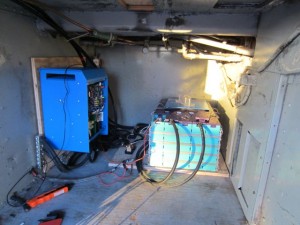
According to the specifications for GBS-LFMP100AHX cells published on the Elite Power Solutions website, our battery cells are rated for:
Operating Temperature: -20C to 65C or -4F to 149F.
But while brainstorming potential causes for our diminished capacity recently, Elite let me know that in their experience heat has a huge impact – even within that operating range.
They have observed that a 10C (18F) temperature increase over a baseline room temperature of ~23C (74F) results in the number of lifetime cycles being cut in half.
This means at 33C (91F) usable battery life will be cut in half, and presumably to a quarter at 43C (109F). This is VERY substantial.
I am disappointed that the impact of temperature on GBS cells does not seem to be documented and published online anywhere (though I don’t feel it was intentionally hid either) – especially considering 110F is actually a rather common summer temperature in Phoenix Arizona where Elite is located!
Had we known this potential impact upfront, we would have definitely approached the installation differently.
Our batteries originally were in a small chamber along with the inverter / charger – and that chamber could get significantly warm when the inverter was working hard powering the roof AC for extended periods.
It never got anywhere close to the 150 degree high-temperature EMS alarm and peak temperature specced for the batteries, but I am beginning to suspect that over the years there might have been enough high-temperature time to have had an impact.
One example – we spent 7-weeks in the summer of 2013 where we were stuck on a hot asphalt parking lot at a diesel shop having our engine rebuilt, and we were depending on the battery bank and our Victron inverter to boost the available wall current to run our AC.
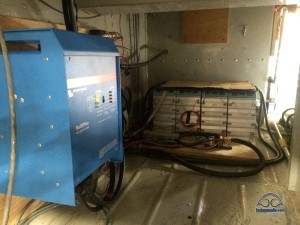
When I rewired the bus last summer I relocated the batteries to a larger and better ventilated rear chamber, so high temperatures are much less likely now.
Another temperature concern is cold – most LFP batteries can be damaged if they are charged while below freezing (discharging is fine – only charging while cold is a problem).
We’ve never had our battery chamber get that cold, but for other people who aren’t able to follow temperate weather this could be a concern.
Elite tells me that they are now recommending RV lithium installs go inside the cabin, such as under a bed or couch, to minimize temperature impact.
Reportedly – one of the secret’s to the battery life achieved by Tesla electric cars is the integrated temperature managements system built into Tesla’s lithium battery banks.
Lesson learned – LFP lab results aren’t taking temperature into account, but RVers absolutely need to.
Suspect #2: Over-Floatation
The final phase of a three stage battery charger is the “float” phase, where the battery is held at a set “float voltage” to keep the battery topped off. In an RV – this float voltage also powers all the DC loads present.
An RV on hookups sits “floating” for days, weeks, or even months at a time.
Lead batteries are generally good with this. Lead batteries love to be charged to 100% full and kept there.
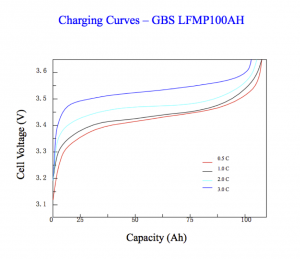
Lithium batteries on the other hand don’t benefit from floating – and in fact evidence is mounting that over time this can actually start to wear on the batteries. For example – an LFP battery is seemingly much happier bouncing between 85%-95% full than being kept pinned at 100% charged.
Just how to best charge and float lithium batteries to maximize battery life remains a widely debated topic (this thread on Cruiser’s Forum currently has 4,246 posts!) – with recommendations varying widely.
But despite a lot of anecdotal reports and experiences shared, most of the actual extended scientific testing of LFP batteries has focused on electrical vehicle applications. Marine and especially RV house battery usage remains a niche within a niche, and advice that applies to a high-voltage high-current never-floating electric car batteries does not necessarily apply to RV usage patterns.
In the past 3.5 years though, the recommended bulk charge and float voltages for RV house lithium banks have been trending downward – sacrificing a tiny amount of peak capacity for a hopeful substantial gain in long-term lifetime.
At the moment I am seeing recommended charge voltages ranging from 13.8V to 14.4V, and float voltages ranging from 13.2V to 13.8V.
We’ve spent the past year using 14.2V bulk charging, and a 13.55V float. I’ll probably soon change to even lower – 14.0V bulk and 13.4V or even 13.2V float.

We’ve dialed back our charge voltages several other times over the years as recommendations have changed, and are still experimenting ourselves. But our higher voltage past may have had an impact, especially when we spent extended periods on full hookups in our first years with lithium.
One trick some lithium pioneers report resorting to is disconnecting their batteries when they are on shore power for an extended period, avoiding any floating risk entirely.
An alternative – a low float voltage of 13.2V should have nearly the same impact as physically disconnecting.
The key here is to make sure your battery chargers are fully programable – especially since few chargers have lithium presets and those that do might be defaulting to higher voltages than you’d life to preserve battery life.
Lessons still being learned – charging and floating isn’t nearly as simple as it seems!
Suspect #3: Lack of Balance / Laggard Cell
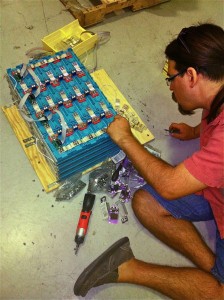
Our battery is made up of twenty 100Ah 3.2V LFP cells, bolted together into a single 4×5 slab.
When we built our battery bank, the Elite EMS for monitoring the individual cells did not support cells in parallel, only in series. So to build a 500Ah bank out of 100Ah cells, groups of five cells are hardwired in parallel and a single sense board monitors each of these four groups in series.
This means that we don’t have the granularity to monitor each of the 20 individual cells – so if we have a laggard cell bringing down the whole bank it is very hard to isolate the troublemaker.
The sense boards are also designed to put a slight balance load on the cells to keep them all in sync with each other – but the balance boards 3.5 years ago did not trigger a balance load until the cell voltage reached 3.7V. This is actually slightly above the over-voltage cutoff on the EMS, meaning that our cells effectively never benefit from being auto-balanced.
In the years since – Elite has improved the EMS design to support cells in parallel with every cell having a dedicated sense board. And balancing now happens at 3.55V, low enough to actually have a passive impact while charging – before the alarm kicks in.
If we were building our battery today we would be able to benefit from these improved designs. But from our own observations – even without the active balancing our cells have stayed remarkably well balanced over time.
But still – perhaps this sub-optimal vintage design has had an impact on battery life, or has made it easier for a dud cell to hide out.
Lesson learned – automatic balancing may be important for longevity.
Suspect #4: The Edge Was Bleeding (And Still Is)
When we built our battery bank in 2011, LFP for RV house battery system use was pretty bleeding edge.
Since then cell quality and consistency has improved, and cell chemistry and construction has been enhanced. In theory – if we were to buy the equivalent cells today that we bought 3.5 years ago, they would in actuality perform better.
We’ve come to understand that 3.5 years ago, a 100Ah cell’s capacity was an optimistic rating. Now a 100Ah cell is more conservatively rated – and would actually start off with higher than 100Ah actual measured capacity when new.
This is the nature of technology – things just keep getting better.
The frontier is no longer quite so uncharted – but even today pursuing LFP is not for the faint of heart.
Lesson learned – Nah, no lesson learned. We knew what we were signing up for.
Reality Check
Checking in with experiences others have shared – I see that a lot of other LFP pioneers have noticed similar capacity losses to what we have – across a diverse range of cell manufacturers.
But some others seemingly have managed to put hundreds of heavy cycles over multiple years on their LFP batteries, and are still able to drain over 100% of rated capacity in controlled tests.
We are clearly all still learning the best ways to get the most out of these batteries.
We also have to choose to strike a balance over how much care and careful attention we want to dedicate to our batteries. For the most part – we just use ours without giving them too much thought, and have gotten 3.5 years of great service so far.
If I hadn’t been doing occasional capacity tests, I would not have even noticed that our batteries had prematurely aged.
And we also need to keep in mind – lead batteries rarely live up to their theoretical ideals either under everyday RV usage. We know plenty of people who end up replacing their lead house batteries every year or two, or who are limping by on lead batteries that are more dead than alive.
Contemplating Cost
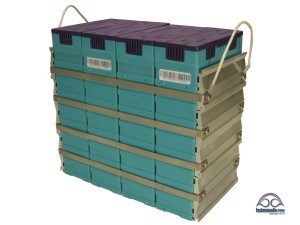
The Elite Power Solutions 100Ah cells we built our battery bank around still cost the exact same as they did 3.5 years ago when we purchased them – $620 for each 4 pack of cells, or $3100 total to build our 500Ah 12V battery bank.
In our initial cost considerations post, we compared our $3100 500Ah lithium battery with the current going rate for 800Ah worth of quality AGM batteries – which we priced out at $1840.
In the years since, lead prices have actually spiked up quite a bit, but at the moment have dropped back down so that the current lead battery pricing isn’t all that different than it was in 2011.
We concluded then:
“There is just no ignoring that a battery bank made up of quality AGM-style lead acid batteries will cost a lot less upfront than a similarly sized lithium battery bank.
But if you consider the lifetime cost, and the fact that lithium batteries should (theoretically) far outlast even the best high-end AGM’s, the math starts to look compelling.”
 Considering that our batteries are seemingly not on track to outlive an AGM bank as much as theory promised, our personal value calculation haven’t worked out nearly as well as we had hoped.
Considering that our batteries are seemingly not on track to outlive an AGM bank as much as theory promised, our personal value calculation haven’t worked out nearly as well as we had hoped.
We don’t keep obsessive records – but my best guess is that we have probably logged no more than 500 cycles over the past 3.5 years, and probably way less. Our Victron BMV-702 battery monitor has only logged 56 charge cycles in the past year since we installed it.
But even if we go with a an extreme high-end estimate of 1000 cycles at 50% average DOD over the past 3.5 years, in theory our batteries should barely be getting broken in.
In practice – our battery bank is only giving us 76% of its original rated capacity. That’s not so good.
But our bank is still meeting our typical needs and very likely still has years left before it can’t keep up with our daily use.
Plus we love living with all the rest of the lithium advantages.
So overall while we aren’t likely to see much of a lifetime cost advantage, the cost question is basically a wash for us.
Has It Been Worth It? Any Regrets?
Despite our system not fully living up to our expectations – it has absolutely been worth it to us.
But remember – we (usually) LIKE being on the bleeding edge.
When we initially designed our dream system for our bus, we had hoped to have 1000+ Ah of battery on board. But 3.5 years ago we decided not to invest so much in such an unproven technology, and went with just 500Ah instead.
We’re sure glad we made that decision… 500AH has been a good balance between risk and reward.
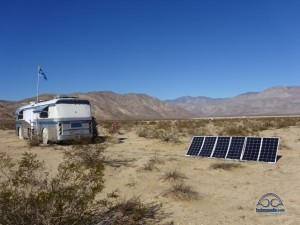
If we were starting from scratch today, we would be able to tap into a vast wealth of experience and assistance that just did not exist when we started. Our own knowledge of RV electrical systems has vastly increased too – in large part we have learned by doing as we tackled this project.
Especially considering that solar-powered boondocking has become an increasingly frequent part of our lives, the advantages of lithium remain too compelling to ignore.
So yes – if we could go back in time and advise ourselves to do lithium again, we would.
And we’d pass along a few pointers: Cooler. Less floating. Better balanced.
And if there is a next time – we’d go even bigger. We have discovered that 500Ah is a great size for us, even at our current reduced actual capacity. But having more battery like we originally envisioned will better let us bridge cloudy days and bad weather while still feeling abundant.
We’ve sized our new battery chamber to be ready for a 1200Ah or 1400Ah battery bank – which could actually run our roof AC overnight, or for a full hot day of leaving the cat home alone.
Hopefully by the time we are ready for our next upgrade, lithium prices will have continued their downward trend, and perhaps even more will be known about optimizing real life usage.
Getting Lithium
In the years since we set off down this path – it has gotten a lot easier to get started with lithium.
You have a few options – you can do what we did and buy raw cells and build you own battery. Or there are now a few reputable RV solar installers who are now offering lithium battery installations too, who can do the hard work for you while offering ongoing handholding and support – and a warranty too.
Here are some of the top options worth researching further that we can personally recommend:
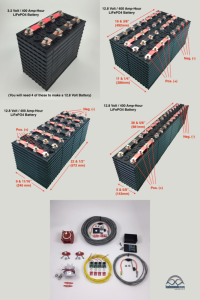
AM Solar – Our friends at AM Solar in Eugene, OR have been experimenting with lithium as long as we have and we’ve swapped many notes with them. They at last have put together an offering they feel comfortable enough selling and supporting. They have packages ranging from 100Ah ($1,199) to 400Ah ($3,299) – all including a full battery management system and even all the necessary wiring and fuses.
Starlight Solar – Another solar installer with a great reputation is Starlight Solar in Yuma, AZ. We’ve swapped notes with Larry at Starlight over email for years, and intend to at last go and meet the Starlight crew in person soon while we are in the area. Starlight has also recently begun doing lithium installs, using the same GBS cells and Elite EMS we have in our bus. A friend of ours recently had a 500Ah LFP system installed by Starlight – and from what we have seen they did excellent work.
Build It Yourself:
If you are brave (or foolish) enough to want to tackle building an LFP battery system yourself, there are a lot of cell providers out there catering to the electric car hobbyist market.
The advantage of going this way is that you can likely end up with a much larger system better suited to your personal needs, all for substantially less upfront cost. But this is only a suitable course if you want to get very intimate with your RV’s electrical system, and are comfortable dealing with any potential issues that arise on your own without relying on anyone else for a warranty or support.
Elite Power Solutions – Even though we are disappointed in how our cells from Elite have aged, we are overall happy with the support we have received from the Elite Power Solutions team. They were excited to help us dive into our project 3.5 years ago, and even now they never hold back from honestly and openly answering any of our questions. We know Elite has been working on an installation tips and tricks guide specifically for RVers too – so they are very worth checking in with. They now have a better understanding of using this technology for an RV application, and claim improvements have been made to both the cells and their EMS.
Elite is the US distributor for GBS cells, recognizable by their baby-blue plastic casing.
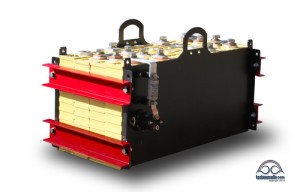
Balqon – When we built our battery, there weren’t any suitable larger cell options for building an RV house battery bank than the 100Ah cells we found from Elite. Building a battery bank bigger than 100Ah thus meant putting cells in parallel.
Now via Balqon there are cells on the market suitable for building much bigger batteries – the largest single cell we’ve seen being the 1000Ah monster from Balqon. Four of those at $1,200 each would build a massive 1,000Ah 12V battery bank.
Balqon seems to primarily stock the 700AH cell sized right now, with larger and smaller cells currently requiring extended lead time.
Balqon also offers some very interesting energy storage systems that integrate the BMS, relays, and fuses into a complete package. The ESS-12V is a 200Ah system for $1,695, the Lithium Battery Storage 9kwhr is 700Ah for $4,050.
We’ve been very tempted by the potential for Balqon’s bigger cells – especially after having seen 700Ah cells briefly show up as low as $560/ea on Balqon’s clearance page a while ago – a price that actually starts to undercut AGM.
The biggest concern with Balqon is that they have unfortunately built up a reputation for poor customer support amongst those we’ve talked with and read about. Balqon has become known for shipping products late, and without documentation.
I can only share my own experience – after having a great phone call with the CEO of Balqon late last year when we were contemplating a battery upgrade, he sounded excited to sign us up to beta test Balqon’s new BMS. But rather than follow up, he then dropped off the map – never emailing the photos and technical details he promised.
As we were on the fence about being willing to invest in a new bank right away anyway, we weren’t overly motivated to follow-up.
Balqon is the US distribute for Winston cells, recognizable by their bright yellow plastic casing.
The Rainbow of Other Cell Options
We know of other RVers currently using GBS cells from Elite, and Winston cells from Balqon – with overall good results.
But there are several other cell manufacturers that you might run across too, and you can usually tell the manufacturer of a cell by the color. CALB is blue, Sinopoly is black (400Ah for $540 here), Winston is yellow, GBS is pale blue, Hipower is white, and so on. I found a reasonable guide to identifying cells by color here.
But whatever color you go with, whether you build a battery bank yourself or rely on a professional, do your homework and know what you are getting into – not all cells or sellers are created equal!
And do remember – it takes four 3.2V lithium cells to make a 12V battery!
“Drop In” Batteries:
There are some companies wrapping up lithium cells into cases designed to resemble traditional lead batteries, suitable for a “drop in” replacement for existing lead configurations.
We have had almost no contact with anyone who has used these batteries in an RV house battery bank (that’s not to say they’re not out there, they’re just less likely to be out pro-activately sharing about them like DIY pioneers might be) – but for the sake of completeness here are some options for further research:
Lithionics – Lithionics has a huge range of sizes on offer, matching up with traditional vehicle battery sizes. The largest is 600Ah 12V600A-8D that seems to sell for over $9,000 – yikes!
Smart Battery – Smart Battery is another “drop in” provider with a range of sizes on offer, the largest being 500Ah for $5,599.
Premium Batteries:
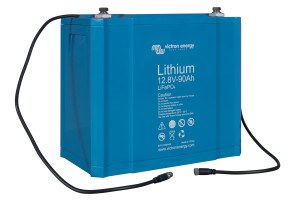 If you really want to go lithium and you have the upfront budget, the same premium options that I mentioned in 2011 are still out there – primarily targeting the high-end marine market.
If you really want to go lithium and you have the upfront budget, the same premium options that I mentioned in 2011 are still out there – primarily targeting the high-end marine market.
Victron, MasterVolt, and GenaSun ($6,399 for 360Ah) all still offer integrated systems that are the exact opposite of do-it-yourself systems.
But if you want an advanced lithium battery bank with premium support, exploring the options from these manufacturers may be worth it.
Is The Frontier Calling You?
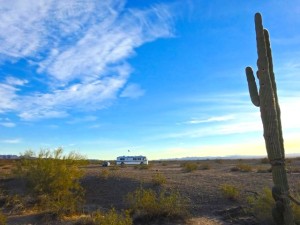
Lithium batteries in RVs might not be as wild of a frontier as it was when we set off exploring in 2011, but it is still an area that is evolving and changing fast.
Things three years from now will likely be even more different than they were three years ago – with more and better options. Hopefully cheaper options too.
So if your current electrical system is doing fine, maybe waiting another year or two is wise.
If you’re at the decision point contemplating a major upgrade, well…
… come on out to the frontier and join us pioneers. A few arrows in the back never killed anyone, right?
*grin*
Has this post been helpful? Has it saved you time, money or from making similar mistakes? We’d love to hear your appreciation – here’s some ideas beyond leaving a comment on how to Say Thanks. (Pssst.. there’s a donate button down below too.. our wine cabinet wouldn’t mind being restocked.)
Posts in this Series:
The Entire Lithium Battery Series
Promise of Lithium #1: Lead Acid Battery Downsides
Promise of Lithium #2: Lithium Ion Battery Advantages
Promise of Lithium #3: Cost Analysis (including our part list)
Boosted Electrons = Better Views (why a boosting inverter rocks!)
Project Notes:
7/2013 — Living in a Parking Lot — Practical use example of our LFP & Boosting Inverter
2/2013 — Lithium Dreams, Lined With Worry? (Response to Boeing Dreamliner Battery Fire)
8/2012 — Our 1 Year Update on our Lithium System
8/2011 — Build Notes: Lithium Ion Battery Success!!
8/2011 — Build Notes: We Built a Lithium Ion Battery Bank
8/2011 — The idea is born: Inverted Intentions (August 2011)
[quote_box_center]Our standard LFP disclaimer — we have no incentive to try to convince anyone else to adopt LFP. We are NOT selling these batteries, we are not affiliates for any of the components, we paid for everything ourselves, we’re not electrical/battery consultants/expert,s nor do we have any financial stake in the technology beyond our own system.
We are simply full time RVing technomads who are designing our own cutting edge home on wheels, and are sharing our independent research & project… because, well, we like to![/quote_box_center]

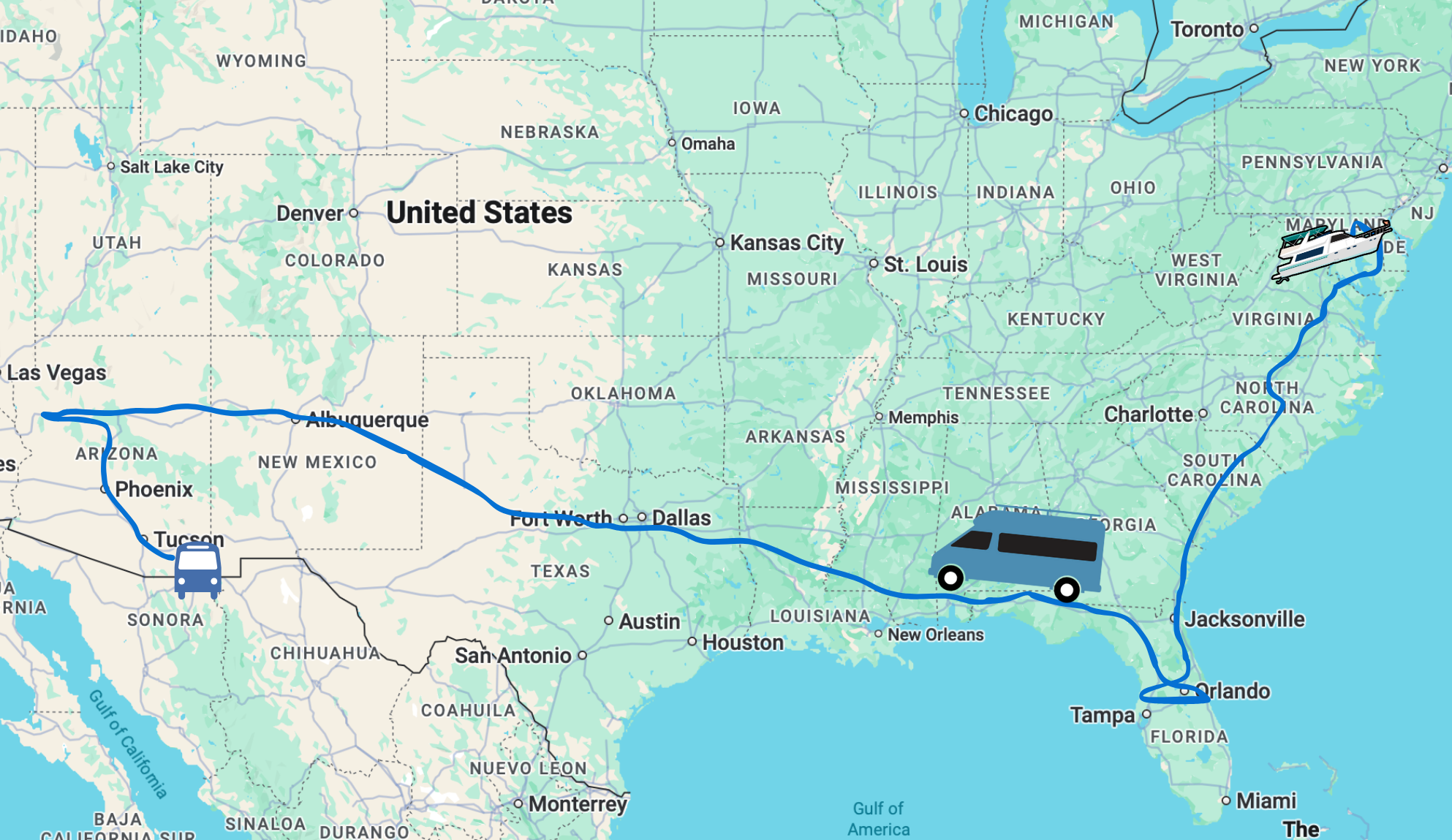
I like what your site has the same the only problem is I’m not I bought some lithium batteries I have three hunt hundred amp hours from battleborn I can’t seem to get them above a resting voltage of 13 to 2:13 to 5 which is roughly 70 to 75% maybe you might be able to help to figure out how I can get them above 70 to 75% my zamp portable suitcase I have 320 watts and it shuts off at about 13.6 volts which is really not a hundred percent because it’s not resting voltage how can I get it above that my solar panels just stop giving me any electricity when there are hours of sunlight left any help would be appreciated thank you my name is Tom
Would recommend contacting Battleborn, your inverter company, your solar and/or installer for support on the products you purchased.
Ideas:
– First, I think you need a programmable charge controller with customizable settings. Highly recommend the Victron Bluesolar line MPPTs. You could get by with the 75/15 or go with the 20 amp one. Well worth it. Get the bluetooth monitoring feature and watch your voltage and charging profile on the app. Make sure your bulk charging voltage is 14-14.4. Float at 13.5 or so.
2) 320 watts may not be enough solar. Actual delivered power will be 75% of that or less. See what your charge controller tells you once you get the Victron. If you are aiming and following the sun, they should do the job on sunny days. I need 200 watts (up to 170 actual delivered) to charge my 100 amp battle born. Sometimes I’m getting 140 watts out of 200 rated. So you might be getting 200-230 out of yours.
3) Use your alternator to charge also, if in a vehicle.The batteries can take it and it will help bring them up.
Funny and well written article indeed! Thank you very much. I have not read anything else by you yet, but the nights are long in Sweden in summer and I have plenty of coffee and time.
I found your posts very interesting. I replaced the AGM house batteries with a lithium battery system in our motorhome at the end of 2015. The AGM system was 540ah and the lithium is 360ah. I also used a Victron 2000/80 inverter/charger, a 50 amp DC/DC converter to connect the truck alternator to the system and 500 watts of solar panels. We also have a Honda EU20I generator.
Some other technical data that you may be interested in:-
Charge voltage 13.8v
Float voltage 13.56v
Absorption (balancing I think) 14.2v
Maximum discharge level 30%
The battery management system keeps the charge between 99% and 100% when on mains power,
I have not done any yield tests so I am not sure how the capacity is going but it supplies all our needs except heating for which we use gas for cooking and diesel for space heating. The system has not given us any problems in the 2.5 years we have been using it. As you say a big advantage is the saving in running the generator and the savings in weight.
Love the details you’ve shared on your LFP system. Just recently discovered your posts. Seems like you’re going thru some of the same learning curves as the folks who design/use remote battery backup systems for mountain top communication systems (yes I’m a geek (Telecom/RF/Antenna engineer). Seems like all battery chemistry’s need to be concerned with temperature, individual cell balance & charge/discharge rates. Seems like you’re getting a handle on all of this & I have learned from your posts! Keep the information flowing you two are doing a great job.
Thanks
Nice press release. Not much specific. No photos, no projected prices. Hope more information comes out and it lives up to the promisies!
I just saw this online:
A new lithium battery, developed by Dutch battery expert Super B, offers campers and boats huge power and energy reserves, so people no longer have to worry about energy provision, charging points or limited power.
The Epsilon weighs substantially less and will last five times longer than conventional batteries, is fully charged within one hour and has more energy than ever before.
http://rvdailyreport.com/industry/epsilon-solves-battery-limitations-for-rvs-boats/
It doesn’t appear to be any different than many of the other lithium battery options that have popped up over the past few years. Do you know if they have lined up any US distributors?
do you teach how to wire your trailer with solar panels and and DIY lithium battery bank such as a tutorial video. I have a sister with cancer. The cost put us in the poor house. We are now trying the off grid living. No one in the southwest part of dakota knows anythinghing about wiring a fifth wheel trailer for solar living. We got our fifth wheel off an auction. We are alo having probelms with a 12 volt system as I tried the system the other day just to run a camper tv for my sister with a single 12 volt fuse inthe panle box and the tv which takes less than 24 watts was on less than 30 mins, then turned off. When I tried to turn it on 6 hours later, the 100 ah batter by exise was completely drained. I know nohting about these systems, but would like to learn.
No, we don’t teach this stuff… but check YouTube, there’s probably lots of folks who have shared their installs.
It’s nice to see a truthful post about lithium ion batteries. They are great but out of so so many of us fulltime RVer price range.
Looks like Balqon may be out of business. Website is offline at least for quite a while now.
Thanks for all the info. Just a question (or two) about the federal tax credit for solar/lithium. First, did the credit exist when you added your system, and if so, is it okay to leave line 7b on Form 5695 blank if your only home is your RV?
We did our lithium install a couple years before our solar install, so we were not able to write-off the battery portion. But we did the solar install. We’re not CPAs, so can’t advise on specifics of filling out the forms – recommend consulting with your tax prep specialist, CPA, bookkeeper, etc.
FWIW: I had a bad connection problem between my two GBH 100ah batteries that made me think they were loosing capacity. I cleaned all connections with sandpaper and added light grease. I then ran an Ah test on both batteries at 0.1C. The three year old battery measured 92ah and the two year old (physically bigger) battery measured 98ah. All is good now and I’m very happy fulltiming with these batteries.
That is great to hear that you were able to solve and isolate your capacity loss.
Someday it might be interesting to dismantle our battery bank and test out each cell individually to see if we can isolate and even rehabilitate any laggards. But that would be a ton of work, and for now our battery bank continues to manage all our typical needs handily.
– Chris
Quick question (I’ve exhaustively searched your blogs and vlogs and most everybody else’s comments – maybe I missed it) –
Are you still running a separate battery for engine starting?
Yes, we have flooded lead acid batteries for our starting batteries. But we can bridge them to the lithium if needed.
Hi, I read over all of your writings with the Lithium pack and the solar setup. There is one thing that as alluded me. The Elite BMS has its own 500A/50mv shunt to it can track usage however the BMV-702 also needs a 500A/50mv shunt to function. Did you share one shunt with both the Elite BMS and BMV-702?
Sorry if this got posted twice. I got busy earlier and though I posted but may have clicked off the page without doing so.
Both systems are designed to use an identical 500A shunt, and thus they can share.
That is how we configured our system.
— Chris
That’s interesting. I was concerned, probably unnecessarily, that the BMV connection might throw off the voltage as measured by the Elite BMS computer (and thus the computed current). So I just connected the shunts in sequence, with a piece of 1″ x 1/4″ copper bus bar in between them. Works fine, though I guess I wasted a little space and time.
Good updated report, I wasn’t going to consider Elite since their balance board couldn’t work in parallel packs but when I found out that’s no longer true I put them back on my list. I’d like to see some upgrades to the CPU module but mainly for a more improved user interface. The programmer in me would love to design a new CPU module using their sense boards although one could get close using a RaspberryPi connected to the CPU using either CNA or the MOD bus option.
BTW, have you considered getting a full set of the new sence boards and rebuilding you pack back to its original configuration but with she’s boards on each cell?
When the time comes for us to get our RV I think I’ll go with the 200A pack even though they are a little more expensive. I really like that pack design.
Given the age of our pack and that we’re switching to part-time RVing soon (with part time boating), it probably wouldn’t be worth the effort.
Ah, the big loop. Are you thinking about Lithium and solar for the boat and if so do you have any idea at all on how much it will take?
Let us find the boat first and figure out its energy needs… we’ll go from there 🙂
Thank You! I have affordable mobile internet access, thanks to you, and am now just beginning to learn about solar, Li batteries. Am a member and will happily renew next year!!
Don Weaver 2012 Discovery 36J
Finished three months in Canada with 9 weeks in Labrador/Newfoundland. Boondocked all but about 7 days and did not use line power. Province permits up to 48 hours of boondocking on Crown and Commons Lands (unless there is a no parking sign). Did run generator once a month as manual suggests. Solar and LFP provided all we needed.
I’m just getting to this area of alternate power from my RV – THANK YOU for the invaluable info!
Hi Chris. I know this post is pretty old now, but I’m curious whether you considered the possibility that the MultiPlus’s long absorption phase may have contributed to the damage to the battery bank.
The minimum programmable absorption time on the Victron is 1h, which I have come to learn is much too long at that higher voltage and results in overcharging. There are a couple of other approaches to wiring up the charger and the BMS that can head off this issue, but I don’t know if you implemented those when you installed the system. Is the absorption phase something you evaluated?
Appreciate all the work you guys to do share your results with those of us still in the planning stages!
/adam
The Victron 1hr absorption is a slight concern, but when the battery is “full” charging current drops to nothing and when I compared notes with our battery cell provider they didn’t think that this was much of a concern at all.
But certainly a system where the battery cells can talk directly with the charger to shut it off immediately would be a bit better.
I don’t think this impacted our battery life issues significantly though. There were much more likely culprits at work.
Cheers,
– Chris
Adam, just curious what the couple other approaches are you referred to? I’m looking to get the Victron multiplus and MPPT controllers, but am running into the same issue. Thanks!
Very helpful info.. Thank you.
Continue to enjoy your blogs and look forward to your writeup of first four years of LFP. We have just finished three years in our 5th wheel (760 amps at 12 V nominal) and are just starting out in our down-sized 2002 Roadtrek 190 (we are keeping the 5th wheel for long stays in western US – and it is our legal home but we wanted something smaller to get into places a 34′ fifth wheel could not get – and if we did get in, then perhaps we could not get out as almost happened in San Miguel del Allende in Mexico last April).
Below is a quick discussion of the system our son designed and fabricated. Yesterday was the start of our current six month trip to Labador/Newfoundland.
Son Cary finished fabricating the solar/LFP array on our 2002 Roadtrek 190. There are two panels: 315 W and 100 W. Since they have different voltages, he had to utilize two chargers. The cabling is run though the a/c housing and down the corner of the left rear door. The battery suite is two x 180 amp (12 V nominal) Manzanita Micro (each is 4 x CALB LFP cells). The batteries are under the bed. Each battery has an internal blower to keep the batteries cool. Son Cary then installed a high efficiency blower that exhausts air to the outside. This will cooper minute from the batteries, inverter (2.5 kW PSWI) and other electronics. It will remove four volumes of air from the “electronics compartment”. We knew that the installation of the batteries, inverter etc pretty much used up the rear storage so we purchased a StowAway box that we installed on the rear of the vehicle.
He designed the system so that we can run off shore power if required. Shore power could be used in two ways. One charges batteries and the AC (120 V) runs off the batteries (this is technique to be used in Mexico and other places where line voltage may vary dramatically and destroy electronics. The other technique disconnects from battery suite and runs through the original wiring of the Roadtrek
Son trialed the system and it works well. He ran the a/c on battery alone for over an hour.
He had one of his technicians install plumbing for an Olympic Wave 3 on the clothing closet. An Olympic Wave 3 should be sufficient to heat the vehicle for any conditions we plan to face. The forced air heater should be able to take up the slack beyond that.
Currently spending three days in Fort Collins and then head towards Labrador/Newfoundland and then take in the changing of the color on the East Coast when the Maples turn red.
Good background article… http://batteryuniversity.com/learn/article/types_of_lithium_ion
Good info!
it seems like charging the batteries below freezing is rough on them but discharging is less so. I’ve been assuming that as long as I don’t charge when the batteries are at or below freezing, I won’t hurt their longevity.